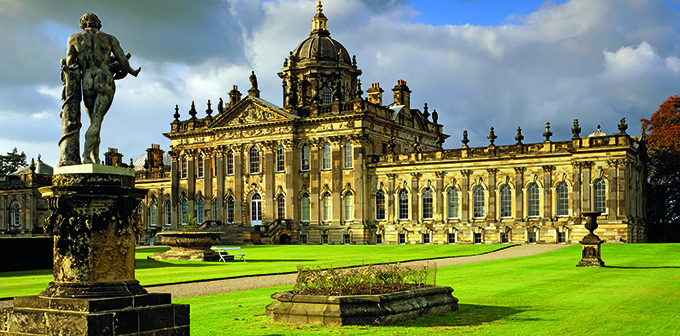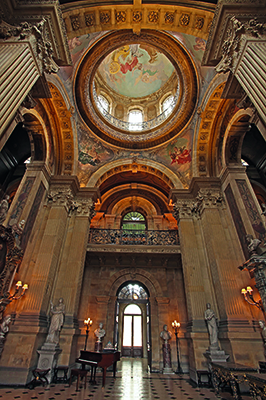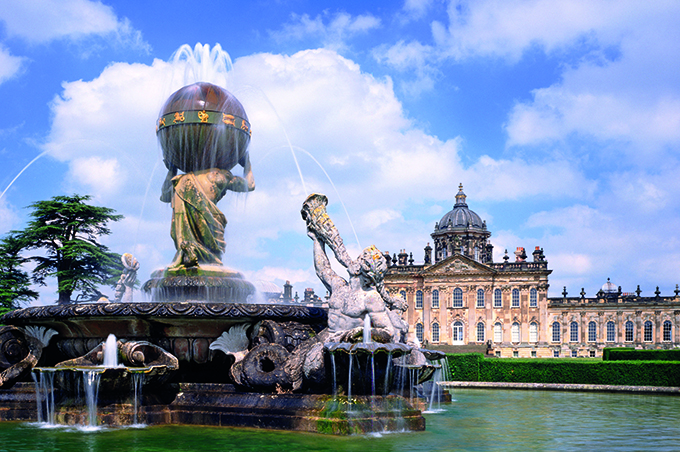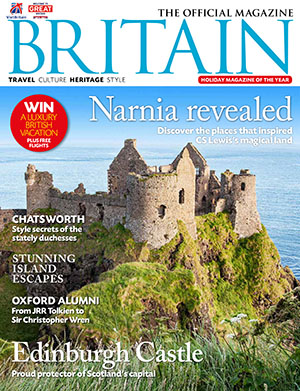Castle Howard in North Yorkshire was designed by an architectural novice, but has since had starring roles in Evelyn Waugh’s Brideshead Revisited and Victoria

It takes quite a leap of faith to employ an ex-soldier turned writer of bawdy plays with no previous architectural experience to design you a palatial country house. And you might question your wisdom when his subsequent endeavours provoke “the petulant sarcasms of factious men of letters”.
Yet today the North Yorkshire stately home of Castle Howard, commissioned from John Vanbrugh in 1699 by Charles Howard, 3rd Earl of Carlisle, is widely acclaimed as a Baroque masterpiece – its dreamy presence amid the Howardian Hills is also ingrained on modern imaginations as the home of the Marchmain family in TV and film adaptations of Evelyn Waugh’s novel Brideshead Revisited.

Whatever the screen incarnation of Castle Howard, visitors soon discover its history proves the old adage that truth is stranger than fiction. The Howard family, still living here, are descended from Lord William Howard, whose father Thomas, 4th Duke of Norfolk, was beheaded in 1572 for plotting against Queen Elizabeth I. William’s great-grandson, Charles, a skilled opportunist, politician and soldier deftly changed sides in the Civil War, was ennobled first by Oliver Cromwell in 1657, and then created Earl of Carlisle by King Charles II in 1661.
Among family portraits watching you as you climb the Grand Staircase at the start of a tour of Castle Howard is the ambitious 3rd Earl. As adept at self-promotion and scheming as his grandfather, he lost no time in gaining a series of influential public and courtly posts; Castle Howard, built on the site of the family’s ruined Henderskelfe Castle, was intended to proclaim his status.
It’s likely the 3rd Earl met John Vanbrugh at the Kit-Cat Club, a gathering of Whigs at the cutting edge of London life. The Earl had already rejected designs for his new country seat from leading architect William Talman and somehow Vanbrugh, notorious playwright and silver-tongued man-on-the-make, convinced him that, despite never having built a house before, he could deliver a creation befitting the times and his patron’s desires.
Unfettered by formal training, Vanbrugh set to his task with an exuberance that challenged accepted custom, though he had the sense to recruit architect Nicholas Hawksmoor to assist him on practical aspects of design – a collaboration that would also pay dividends at Blenheim Palace, Vanbrugh’s other great Baroque masterpiece, begun in 1705.
Instead of building on a traditional east-west axis, Vanbrugh boldly gave Castle Howard a north-south orientation to make the most of the sunshine and views. Two projecting wings were envisaged from the outset but the idea for a dramatic dome – the first of its kind on a private residence in England and the crowning glory in all senses – only came after construction had begun. Giving the outside of Castle Howard its unique silhouette, on the inside the dome rises 21 metres above the Great Hall, a theatrical triumph of columns, carvings, frescos and space. Ethereal painting by the Venetian artist Antonio Pellegrini culminated high overhead with the tale of Phaeton tumbling to earth from his father’s sun chariot.
The building’s facades bristled with carved decoration, coronets and coats of arms, while statues and urns filled niches. If Doric pilasters on the north front seemed at odds with Corinthian on the south front it was retorted that nobody could view both simultaneously.

Plans for gardens and grounds were equally unrestrained and monumental with a pyramid, the Temple of the Four Winds and a majestically colonnaded mausoleum – still the private burial place of the Howard family. Work on lakes continued through the 18th century, and in the 19th century the 7th Earl of Carlisle would add the famous Atlas Fountain at the centre of the South Parterre.
While some 18th-century commentators were horrified by the flamboyance others, like man of letters Horace Walpole, considered it “sublime”. Yet one feature struck a dissonant note: the West Wing, built in the 1750s after the deaths of Vanbrugh and the 3rd Earl, was Palladian in style, a sober contrast to the existing Baroque designs. The 4th Earl came to regret what he had allowed and, to this day, the asymmetrical appearance of the house and its two mismatched wings both charms and raises eyebrows.
Back inside, in the Antique Passage, Long Gallery and other opulently furnished rooms, antique sculptures and paintings collected by the 3rd, 4th and 5th Earls on Grand Tours of Europe exude classical connoisseurship. (Letters written by the 4th Earl, worrying about pirates and tactics to prevent officials inspecting crates, suggest collecting wasn’t all plain sailing.) Renowned English painters such as Thomas Gainsborough and Joshua Reynolds are represented too, as well as works by George, the 9th Earl, a talented Victorian artist in his own right – see his landscapes in the Museum Room.
What a frightening thought, then, that Castle Howard could have been lost when a chimney fire broke out on 9 November 1940, sweeping into the Great Hall and destroying the dome and nearly 20 rooms. It seemed unlikely the house would be lived in again. Further tragedy struck as two Howard sons were killed in action during the Second World War. But middle son, George – grandson of the 9th Earl and father of the current generation who care for Castle Howard – returned to restore the home.
It has been a slow, painstaking task, which has included the rebuilding of the dome and the recreation of Pellegrini’s Fall of Phaeton painting by Canadian artist, Scott Medd. The story of the fire, continuing restoration works and how derelict rooms gained new life as sets for TV and film is told in the Brideshead Restored exhibition.
Visitors can also explore the award-winning Duty Calls exhibition revealing a little-known chapter in the history of the family and estate from Waterloo to the Second World War. Between 1815 and 1944, five Howards were killed in action, while on the Home Front Castle Howard catered for Belgian refugees and schoolgirl evacuees who helped to salvage house contents from the 1940 fire.
This feature appeared in the July/August 2016 issue of BRITAIN
Related articles
|
Click here to subscribe! |
Download BRITAIN Magazine to your mobile today

 No mobile device? Purchase directly on Zinio for your desktop!
No mobile device? Purchase directly on Zinio for your desktop!





 © 2024
© 2024